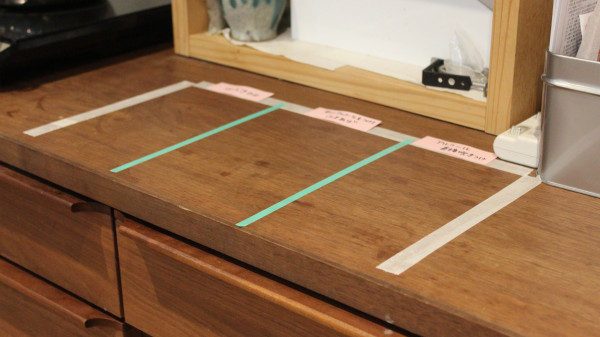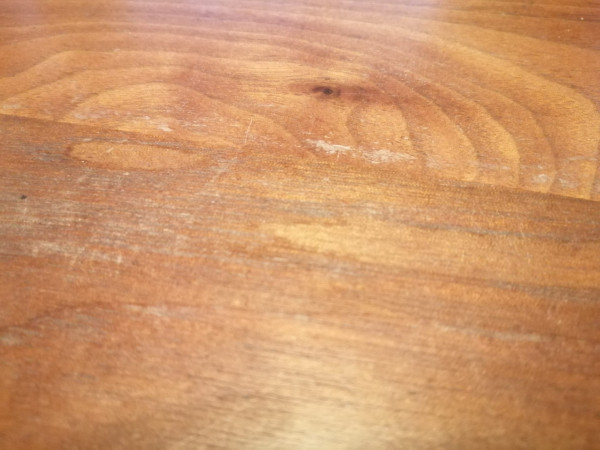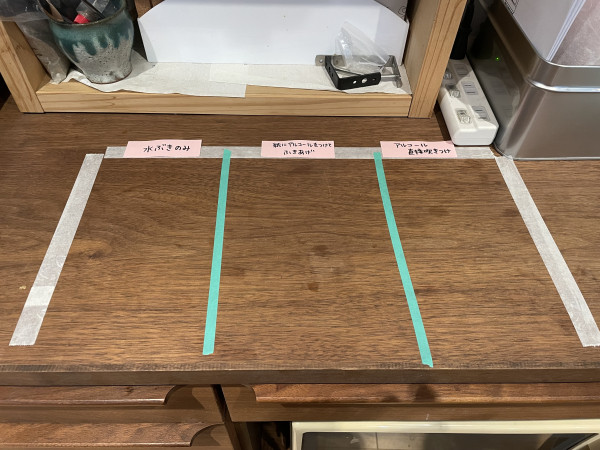This year's rainy season brought continuous rain, leading to indoor humidity and dampness. Have you noticed a faint white dust-like substance on the surface of your furniture during such times? Believe it or not, that could be mold.
Wooden furniture placed in areas like the dining room, bathroom, or washroom is more prone to developing mold due to the high moisture levels in these surroundings.

Even in our company, a kitchen counter that's been in use for over five years without proper maintenance ended up developing small patches of mold. The tabletop had dried out and turned white, with noticeable water rings.
(Note: The masking tape in the images is for experimentation purposes, making visibility difficult. We apologize for the inconvenience.)
Therefore, we decided to try cleaning the counter by wiping it with a damp cloth or alcohol, followed by applying furniture oil since it was originally oil-coated. Below are the results of various attempts.
For those who find videos more helpful, please refer to the following links:
Here's the state of the furniture before cleaning: The tabletop has turned white, as if the color has faded, due to drying out. There are black spots in some areas, which are water rings. Small patches of mold have also developed near the border between the drawers and the tabletop.
- Water Wipe Only
- Wiping with Alcohol-Soaked Paper
- Direct Application of Alcohol
Start by quickly dry wiping the surface to remove dirt. Then, try the three methods mentioned above to clean it, and afterwards, apply an oil finish.
- Water Wipe Only
For routine cleaning, it's sufficient to wipe with a cloth that's been wrung out tightly, followed by a dry wipe to let it air-dry.
- Wiping with Alcohol-Soaked Paper
- Direct Application of Alcohol
Since mold was a concern for this counter, we decided to use alcohol. (Please note that alcohol might cause discoloration, so it's not highly recommended.) Using alcohol on furniture with a polyurethane finish could potentially cause whitening.
We used commercial alcohol in a spray bottle for this purpose. While household alcohol can also be used, be cautious with alcohol that has a high concentration, as it might cause discoloration in solid wood. We've experienced instances where wiping with alcohol-soaked sheets turned the wood white.
Another table wiped with alcohol-soaked sheets ended up like this...

We used alcohol with 67.9% ethanol content this time. Even after applying alcohol, we didn't notice any discoloration.

Since alcohol didn't cause discoloration either, we used a piece of paper with residual alcohol to quickly wipe off the mold.
For regular maintenance, use a damp cloth followed by a dry one to thoroughly dry the wood. If mold is present or you want to prevent it, slightly dampen a paper with diluted alcohol and wipe. This should suffice.
Now that the alcohol has dried, let's apply oil. We're using furniture oil that we sell in our company. Some people buy it along with their furniture, while others purchase it separately. There are sets that include a cloth, making immediate maintenance convenient.
(Note: If you're sensitive to smells, do this in well-ventilated areas.) Oil maintenance is usually needed once or twice a year. Best times for this are around May before the rainy season when ventilation is easy, or around October before winter.
Applying Oil:
- Single Coat of Oil
- Two Coats of Oil
- Three Coats of Oil
First, apply oil onto a cloth and spread it evenly. Let it sit for 20-30 minutes, then wipe off the excess oil with a dry cloth. Let it air dry for 1-2 hours. Repeat this process.
Since the counter had been neglected for over five years, there wasn't much change with just one coat of oil.
After two coats of oil and thorough drying, the water rings became less noticeable, the texture turned glossy and smooth, and the surface became silky. We tried three coats of oil, but it didn't seem necessary.
If you've recently purchased furniture, one coat might be sufficient. If drying and water rings are concerns, trying two coats could yield better results.
If you're struggling with furniture maintenance like us, it takes time but is quite simple. Feel free to use this as a reference.


